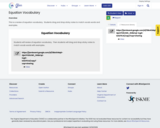
Concept of Variable Algebra Readiness Formative Assessment
- Subject:
- Mathematics
- Material Type:
- Assessment
- Provider:
- VDOE
- Author:
- VDOE
- Date Added:
- 10/07/2024

Concept of Variable Algebra Readiness Formative Assessment

Solve Two-step Linear Equations in One Variable Formative Assessment - Just in Time Quick Check, Teacher Notes, and Supporting Resources

Solve One and Two-step Linear Inequalities Formative Assessment - Just in Time Quick Check, Teacher Notes, and Supporting Resources

This is a digital sort of terms for equations and expressions. Students are able to sort terms the teacher provides, the given equation, and create their own equation. https://jamboard.google.com/d/1xT6VfZwn38OcLnmGz2OsX29ci6jbmN4iCrtqo7JgPT4/copy?usp=sharing

This is a review of equation vocabulary. Students drag and drop sticky notes to match vocab words and examples.

Just in Time Quick Check Concept of Variable

Video Description: How does NASA test ideas, like the Mars Helicopter, before they are even built? Find out more about this revolutionary helicopter and how NASA uses mathematical modeling to turn complex ideas into solvable equations that help shape future missions. Video Length: 3:20.NASA eClipsTM is a suite of online student-centered, standards-based resources that support instruction by increasing STEM literacy in formal and nonformal settings. These free digital and downloadable resources inform and engage students through NASA-inspired, real-world connections.NASA eClips Real World segments (grades 6-8) connect classroom mathematics to 21st Century careers and innovations. They are designed for students to develop an appreciation for mathematics through real-world problem solving.

This is a Jamboard of writing equations with Algebra tiles. Students will use the key to write the equation.